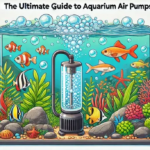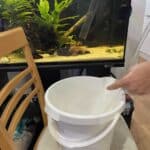As I have gotten more, and bigger, fish tanks over the years, water changes have lost some of their charm. While I love being able to provide a clean home for my fish, and to see them swim about in the clean water happily once I’m finished, carrying the multiple and heavy buckets and cleaning up after the spilt water had reduced my excitement around the task. So, I thought I’d give the Python Water Changer a go. In this post, I’ll share my experience after using it for my freshwater fish tanks for the last few months.
What is the Python Water Changer?
The Python Water Changer is an ingenious idea, replacing the need to lug heavy buckets around for your water changes. It lets you drain and refill your fish tank using your sink. It hooks up to your faucet (it comes with a range of attachments for this) and uses water pressure to start the siphon, so you can clean your gravel (it comes with a built-in gravel vacuum on one end) and change water in one smooth process. You can then reverse the flow, and fill your aquarium up directly from that same facet.
How does the Python Water Changer Work? A Step-by-Step Guide
The Python Water Changer can feel a little unwieldy the first time you use it, especially if you buy one of the longer models. However, once you work out those new-out-of-the-box coils in the hose, it’s a breeze to use. Here’s a quick step-by-step guide to walk you through how it works from start to finish.
Step 1: Set Up at the Sink
- Attach the Python to your faucet.
First you’ll need to unscrew the end of your faucet. This might be quite tight if it hasn’t been opened in a while. Wrapping a rubber band around the end can help with grip, if it is needed.

The product will come with a variety of adaptors brass and plastic. One of these will hopefully fit your tap. Screw it on finger tight, then also attach the rest of the green attachment. (If the attachments do not fit, then there should be a rubber attachment that you can slot over the end of your tap and tighten in place using the metal grip.)
If it is the first time you have used the product, make sure to connect the tubing at both ends: one to the green faucet attachment and the other to the gravel cleaner. You should also see a white switch closer to the gravel cleaner. This allows you to control the flow of water within the pipe, for now, keep it set to open (the white switch pointing down the pipe).

- Switch the valve to “drain” mode.
The little green valve near the faucet, at the bottom of the attachment, is your control hub. By twisting this, you direct the flow of the water either into the sink, or down the pipe towards your fish tank. For now, set it to pour water into the sink. This will help to create suction (negative pressure) and will draw water out of your tank.
- Turn on the cold water.
A medium-to-strong flow usually works best. The water pressure will create suction to start draining your tank through the gravel tube. (At this point you should still be holding the other end of the python water cleaner – the gravel vacuum.)
Step 2: Start Draining Your Tank
- Place the gravel vacuum tube in your tank.
Gently press it into the substrate to clean while draining. Move it around slowly to avoid stirring up too much mess. See here, for a more detailed guide on how to clean the gravel/substrate in your fish tank.
- Watch the flow.
The water should flow steadily out through the hose and down the sink. If it’s weak, check the faucet pressure or hose for kinks.
- Keep an eye on the water level.
Don’t get distracted. It’s easy to accidentally drain more than you meant to! Aim for ~25–30% of your tank volume.
Step 3: Switch to Fill Mode
- Turn off the faucet for a moment.
This gives you a clean transition and helps to avoid splashing.
- Flip the green valve to “fill.”
This changes the water direction so it will now run from the faucet into your tank.
- Turn the faucet back on and adjust the temperature.
Mix hot and cold water to roughly match your tank’s temp. (Too much of a temperature change can shock your fish.)
Step 4: Refill Your Tank
- Place the vacuum tube securely in the tank.
You can clip it to the side or just hold it. I use my fish tank lid to hold it in place, by sliding the glass over it half way.


- Add dechlorinator directly to your tank water.
Add your water conditioner before refilling your tank. Give it a minute to mix throughout the existing tank water. (I normally pour it into the outflow of my water filter to help speed this up.) Remember, that dechlorinator works almost instantly, so, as long as it is in your tank before adding the fresh water, your fish should be okay.
- Turn the faucet on and watch the fill level.
Turn your faucet back on. Tap water should now be running back into your fish tank. Again, don’t walk away! It fills quickly, so don’t let it spill over.

Step 5: Wrap Up and Store
- Turn off the faucet.
Once the tank is full, switch off the water and remove the vacuum tube from the tank.
- Drain the hose.
Let any remaining water drain back toward the sink so you don’t end up with a hose full of gunk.
- Coil and store.
Coil the hose neatly to prevent kinks or cracks. Store it somewhere dry to keep it in good shape. That’s it, you’re all done!
A Few Bonus Tips:
- Always double-check the valve direction (both on the green attachment and the white one on the pipe) before turning the faucet on.
- Don’t forget to clean the gravel tube between uses. The nice thing about this product is that by the time your tank is refilled you have already rinsed the tubing out with fresh water.
- If the suction isn’t working, check for air leaks at the faucet connection or try tightening the hose connectors.
Choosing the Right Size for your Python Water Changer
The Python Water Changer currently comes in 3 sizes, 25ft, 50ft, and 75ft. The size you choose will depend on the distance between your tank and the sink/faucet that you want to connect the other end to. I measured this out using a retractable tape measure. For most users, 25ft will be sufficient. But, if in doubt, do what I did and go a size up. If you find that length is then a little too long and unmanageable, it’s really easy to then cut the tube to size and reconnect the hose attachments to the new length.
Do keep in mind that longer hoses mean a reduced water pressure and a greater risk for kinks. Both of these things can slow the flow of the water. So, these can be two good reasons to cut the tube closer to the length that you need if it is too long.
You may also want to keep in mind any potential future changes in room layout that could impact the length of hose you’ll need too!
My Experience Using the Python Water Changer
I came to this product knowing that I was a little over bucket water changes, but was uncertain if the python water changer lived up to the hype online. I have been testing it on my 34 gallon tank (~130L) for the last couple of months. To be honest, it has been a game changer.
25-30% of my tank would take me anywhere between 6 and 10 buckets to empty and refill. With the flow restrictions on my faucets, this process took a significant amount of time and no matter how careful I was, there was always spilt water on the floor afterwards.
Using the python water cleaner has been faster and cleaner. I won’t be going back to buckets again for this tank.

I have found it difficult to get consistently good water pressure to suck the water out of my tank using the faucet attachment. This may be due to the height differences. I was never a fan of leaving the tap running just to empty water from my tank, and it all going down the drain! We are in a drought prone location. So, for me, it has been working well to empty the tank by running the hose out to my garden (great that it’s long enough for this!). This also gives me the option to collect the water to use on my vege bed in the summer months too. I have then just been reconnecting the hose end to the faucet when ready to refill the tank instead.
The gravel cleaner and tube diameters are both wider than the standard gravel cleaners you would pick up from the store. This means that water transfers in and out of the tank much faster, compared with using the other siphons we have. It does, however, mean that with this cleaner it’s a little tricker to get into those hard to reach areas of the tank. A small price to pay for the ease of the water change, but worth keeping in mind for heavily decorated tanks. You will need to do a more manual clean for these spots at another time.
The only other thing I would say associated with those two points is that this product is not going to be as helpful for cleaning smaller fish tanks. The water will be removed too quickly, and the vacuum might be too bulky for the tank. I’d say maybe to aim for 20 gallons (75 litres) and up.
In terms of ease of use, I found the product really intuitive. It was straightforward to put together and get working on its first use. I also like the addition of the dial valve closer to the gravel vacuum head. You can use it to control the flow of the water, and it gave me peace of mind that I could quickly stop the flow if a fish or shrimp decided to swim up into the vacuum, to keep all the aquarium inhabitants safely within the tank.

To help set the correct water temperature, I picked up a cheap laser temperature gun. I use it to check the water in my tank, then use it to set the temperature of the water running out the faucet before sending it back into the tank.
While it does cost a little more than a standard siphon and bucket, the product feels very durable, and saves so much time (and mess) during the cleaning process. I would definitely recommend it!
If it sounds like something you might be interested in, why not check it out here and see a few more of the raving reviews about it!
Here are also a compiled list of the accessory links mentioned in this post:
Python Hands-Free and Spill Free Aquarium Hook
Python Faucet Adapter for Aquarium







